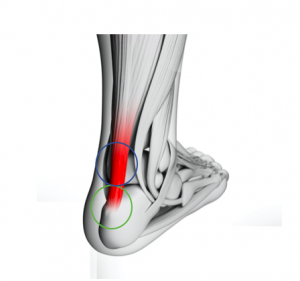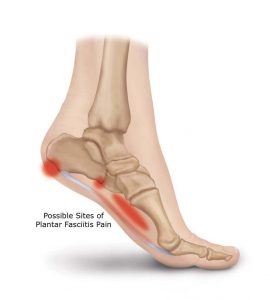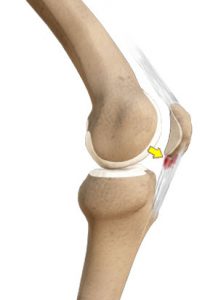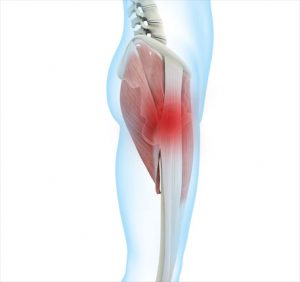Most Common Running Injuries
In a perfect world, there would be no running injuries. But, in reality, they are a very common part of the sport. Although they can be frustrating, running injuries can be easily managed and prevented. Researchers asked 3,276 runners what injuries they experienced over a 12 month period. Based on their results, we have created a list of the most common running injuries.
Are you interested in speaking with a physical therapist about your injury? Schedule your FREE discovery phone call!
Medial Tibial Stress Syndrome

Medial tibial stress syndrome is an umbrella term for pain in the shin. Many runners refer to this pain as ‘shin splints’. During a 12 month period, about 20% of all runners experience this pain meaning it is very common. This is an overuse injury of the main bone in our shin, the tibia. With repetitive loading, the shin and the muscles attached to it become irritated. When left untreated, this injury can lead to a tibial stress fracture.
Runners with medial tibial stress syndrome will have a vague, diffuse pain along the shin that bothers them while running. The spot where the shin bone meets the muscles can be tender to touch. When it first begins, it will only be present at the beginning of a run. As it progresses, there will be pain throughout a run and after. In severe cases, the pain can be present when walking or at rest.
Physical therapy for medial tibial stress syndrome involves modifying the training program to reduce, but not eliminate, running. Furthermore, rehabilitation involves strengthening of the lower extremity, especially the muscles in the calf and shin. Runners with this pain should have their gait analyzed
Achilles Tendinitis

The Achilles tendon is the tendon that connects our calf muscles to our heel bone. This tendon allows us to run and jump. During a 12 month period, about 11% of runners will experience Achilles tendinitis. A tendinopathy is an umbrella term for all conditions of the tendon including a tendinitis, which refers to an acute tendon injury.
Runners with Achilles tendinitis will experience pain directly above their heel while running. When the pain first begins, it is most painful at the beginning or end of a run. At this stage, the tendon can be swollen, red, and tender to touch. If the pain persists, it can last throughout a run or even when walking or at rest. During this stage, the calf can be weak and range of motion may be limited.
Physical therapy for an Achilles tendinitis involves restoring full range of motion and aggressive calf strengthening. The Achilles tendon attaches to a group of muscles known as the plantarflexors. The plantarflexors can be strengthened with exercises such as heel raises. It is important to correctly dose the resistance and frequency of this strengthening.
Plantar Fasciitis

The plantar fascia is a thick piece of connective tissue between our heel and our toes. It provides stability to the arch of our foot and, in addition, it functions as a spring so that we can transfer energy in order to run and jump. During a 12 month period, about 10% of runners experience plantar fasciitis, which is pain and inflammation of the plantar fascia. There are many reasons someone can experience this pain, but most often it is due to overuse.
Runners with plantar fasciitis will experience pain at the inside of their heel that is first noticed when stepping out of bed in the morning or after prolonged periods of sitting. The pain gets better as they continue to walk, but it will get worse with prolonged activity, such as running. It is often tender to the touch.
Physical therapy for plantar fasciitis involves manual therapy and stretching to maximize the range of motion of the ankle. Manual therapy is when a physical therapist uses their hands to help improve range of motion. Aggressive strengthening of the calf muscles is recommended in order to improve the leg’s ability to handle the forces of running.
Patellar Tendinitis

The patellar tendon connects our knee cap to our shin bone. When the quadriceps muscle contracts, it pulls through the patellar tendon to straighten the knee. This motion happens about 1,000 times per mile of running. During a 12 month period, about 22% of runner experience patellar tendinitis, which is pain and inflammation of the patellar tendon. It is also often called ‘ jumper’s knee’ because of it is common in sports that involve jumping such as basketball or volleyball.
Runners with patellar tendinitis will feel pain in the front of their knee while running. Initially, the pain will improve as a runner warms up and continues there run. With continued duration, the tendon can be painful, swollen, and tender to touch. If left untreated, it can progress to being painful with everyday activities such as getting out of a chair or going up and down stairs.
Physical therapy for patellar tendinitis involves aggressive strengthening of the quadriceps muscle and patellar tendon. The goal of physical therapy is to strengthen the tendon so that it can tolerate the large force of running. Other treatments include stride modification to improve the runner’s gait and running efficiency.
Trochanteric Bursitis

Trochanteric bursitis is an umbrella term referring to any pain on the outside of the hip. Oftentimes, the bursa is not actually inflamed, but the pain is from the muscles or tendons near the bursa. During a 12 month period, about 9% of runners experience a trochanteric bursitis. There are many reasons someone can experience this pain, but most often it is due to a change in activity.
Runners with trochanteric bursitis will experience pain on the outside of their hip. They feel the pain when running, but also when something touches the outside of the hip, including lying in bed on the painful hip.
Physical therapy for plantar fasciitis involves modifying, but not eliminating, the running program. It also includes strengthening of the gluteal muscles, which are the muscles of the buttocks that extend the hip. The goal of physical therapy is to decrease pain and improve strength so the runner can return to running.
Are You Interested in Speaking with a Physical Therapist About Your Injury?
Schedule your FREE discovery phone call with an Elevate Physical Therapist.

